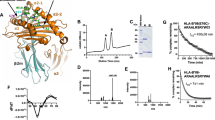Abstract
Foreign protein antigens must be broken down within endosomes or lysosomes to generate suitable peptides that will form complexes with class II major histocompatibility complex molecules for presentation to T cells. However, it is not known which proteases are required for antigen processing. To investigate this, we exposed a domain of the microbial tetanus toxin antigen (TTCF) to disrupted lysosomes that had been purified from a human B-cell line. Here we show that the dominant processing activity is not one of the known lysosomal cathepsins, which are generally believed to be the principal enzymes involved in antigen processing, but is instead an asparagine-specific cysteine endopeptidase. This enzyme seems similar or identical to a mammalian homologue1 of the legumain/haemoglobinase asparaginyl endopeptidases found originally in plants2 and parasites3. We designed competitive peptide inhibitors of B-cell asparaginyl endopeptidase (AEP) that specifically block its proteolytic activity and inhibit processing of TTCF in vitro. In vivo, these inhibitors slow TTCF presentation to T cells, whereas preprocessing of TTCF with AEP accelerates its presentation, indicating that this enzyme performs a key step in TTCF processing. We also show that N-glycosylation of asparagine residues blocks AEP action in vitro. This indicates that N-glycosylation could eliminate sites of processing by AEP in mammalian proteins, allowing preferential processing of microbial antigens.





Similar content being viewed by others
References
Chen, J. M.et al. Cloning, isolation, and characterisation of mammalian legumain, an asparaginyl endopeptidase. J. Biol. Chem. 272, 8090–8098 (1997).
Kembhavi, A. A., Buttle, D. J., Knight, C. G. & Barrett, A. J. The two cysteine endopeptidases of legume seeds: purification and characterization by use of specific fluorometric assays. Arch. Biochem. Biophys. 303, 208–213 (1993).
Dalton, J. P., Hola Jamriska, L. & Bridley, P. J. Asparaginyl endopeptidase activity in adult Schistosoma mansoni. Parasitology 111, 575–580 (1995).
Bennett, K.et al. Antigen processing for presentation by class II major histocompatibility complex requires cleavage by cathespin E. Eur. J. Immunol. 22, 1519–1524 (1992).
Riese, R. J.et al. Essential role for cathepsin S in MHC class II-associated invariant chain processing and peptide loading. Immunity 4, 357–366 (1996).
Rodriguez, G. M. & Diment, S. Role of cathepsin D in antigen presentation of ovalbumin. J. Immunol. 149, 2894–2898 (1992).
Hewitt, E. W.et al. Natural processing sites for human cathepsin E and cathepsin D in tetanus toxin: implications for T cell epitope generation. J. Immunol. 159, 4693–4699 (1997).
Watts, C. Capture and processing of exogenous antigens for presentation on MHC molecules. Annu. Rev. Immunol. 15, 821–850 (1997).
Chapman, H. A. Endosomal proteases and MHC class II function. Curr. Opin. Immunol. 10, 93–102 (1998).
Fineschi, B. & Miller, J. Endosomal proteases and antigen processing. Trends Biochem. Sci. 22, 377–382 (1997).
Lu, J. & van Halbeek, H. Complete 1H and 13C resonance assignments of a 21-amino acid glycopeptide prepared from human serum transferrin. Carbohydr. Res. 296, 1–21 (1996).
Fearon, D. T. & Locksley, R. M. The instructive role of innate immunity in the acquired immune response. Science 272, 50–54 (1996).
Medzhitov, R. & Janeway, C. A. J. Innate immunity: the virtues of a nonclonal system of recognition. Cell 91, 295–298 (1997).
Wyatt, R.et al. The antigenic structure of the HIV gp120 envelope glycoprotein. Nature 393, 705–711 (1998).
Botarelli, P.et al. N-glycosylation of HIV gp120 may constrain recognition by T lymphocytes. J. Immunol. 147, 3128–3132 (1991).
Davidson, H. W., West, M. A. & Watts, C. Endocytosis, intracellular trafficking, and processing of membrane IgG and monovalent antigen/membrane IgG complexes in B lymphocytes. J. Immunol. 144, 4101–4109 (1990).
Barrett, A. J. & Kirschke, H. Cathepsin B, cathepsin H and cathepsin L. Methods Enzymol. 80, 535–559 (1981).
Makoff, A. J., Ballantine, S. P., Smallwood, A. E. & Fairweather, N. F. Expression of tetanus toxin fragment C in E. coli: its purification and potential use as a vaccine. Biotechnology 7, 1043–1046 (1989).
Lane, D. P. & Harlow, E. Antibodies: A Laboratory Manual (Cold Spring Harbor Laboratory Press, 1988).
Lanzavecchia, A. Antigen-specific interaction between T and B cells. Nature 314, 537–539 (1985).
Pond, L. & Watts, C. Characterization of transport of newly assembled, T cell-stimulatory MHC class II-peptide complexes from MHC class II compartments to the cell surface. J. Immunol. 159, 543–553 (1997).
Acknowledgements
We thank M. Ferguson for helpful discussions and advice; E. Smythe and L. Grayson for advice and technical assistance; B. Spruce, A. Knight and the BTS (Ninewells Hospital) for help with blood monocyte preparation; and our colleagues for many helpful comments on the manuscript. This work was supported by the Wellcome Trust and by an EMBO Long-term fellowship to B. M.
Author information
Authors and Affiliations
Corresponding author
Rights and permissions
About this article
Cite this article
Manoury, B., Hewitt, E., Morrice, N. et al. An asparaginyl endopeptidase processes a microbial antigen for class II MHC presentation. Nature 396, 695–699 (1998). https://doi.org/10.1038/25379
Received:
Accepted:
Issue Date:
DOI: https://doi.org/10.1038/25379
- Springer Nature Limited
This article is cited by
-
An infection-induced oxidation site regulates legumain processing and tumor growth
Nature Chemical Biology (2022)
-
Oral immune dysfunction is associated with the expansion of FOXP3+PD-1+Amphiregulin+ T cells during HIV infection
Nature Communications (2021)
-
δ-secretase in neurodegenerative diseases: mechanisms, regulators and therapeutic opportunities
Translational Neurodegeneration (2020)
-
Class II MHC antigen processing in immune tolerance and inflammation
Immunogenetics (2019)
-
Mouse Antibody of IgM Class is Prone to Non-Enzymatic Cleavage between CH1 and CH2 Domains
Scientific Reports (2018)





